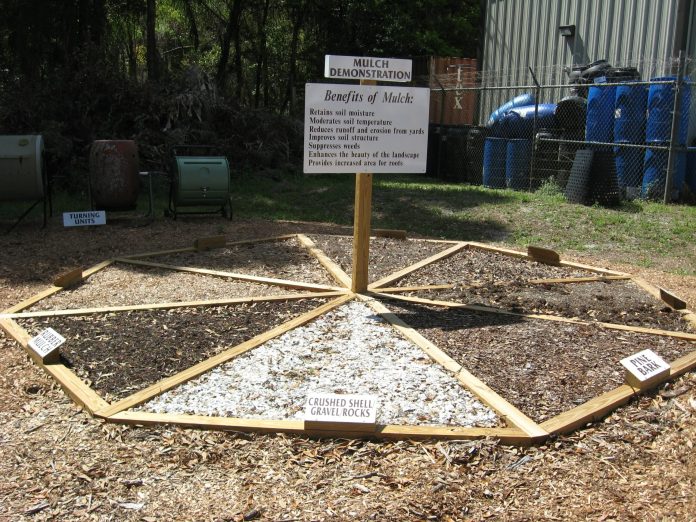I love to mulch. It’s relaxing; I’m outdoors and can see immediate results of my labor. It’s multitasking too: mulching while thinking about installing microirrigation in a landscape bed, starting seeds, what to divide, relocate or conquer. Early morning, before the heat of the day, is a great time to add mulch to your landscape beds.
Mulch is very beneficial. It retains moisture in the soil; suppresses weeds; adds nutrients to the soil as it decomposes, which improves soil structure; moderates soil temperature; reduces runoff and erosion from your yard; provides increased area for root growth; protects plants from lawnmowers and weed eaters; and enhances the beauty of your landscape.
Mulch can be organic or inorganic. Organic mulches include:
• Pine bark, a byproduct of the timber industry that has good color retention. Purchase the medium or small size as the large size tends to float away in a heavy rain.
• Pine straw, another timber industry byproduct that settles quickly.
• Eucalyptus, which is produced from Florida plantations, has a light reddish-brown color and minimal settling over time.
• Melaleuca, which has high termite resistance, almost no settling over time and is produced from an invasive, non-native tree.
• Oak leaves, a free source of mulch that has minimal settling over time and creates ‘self-mulching’ areas under trees.
Municipal yard waste will be available at county recycling facilities when they reopen.
The University of Florida (UF) does not recommend Cypress mulch because it’s not a renewable resource and harvesting destroys the habitat for native birds and animals.
Inorganic mulches include:
• Crushed shell, gravel and rock, which provide nice texture and color in landscape beds but don’t prevent weeds to the extent organic mulches prevent them. They reflect heat, preventing soil moisture loss.
• Recycled tire/rubber mulch, which lasts for a long time, can be quite costly and may contain high zinc levels in leachate that may harm plants (based on USDA research). Rubber mulch can be flammable, and there may be issues with using this because of stormwater runoff and chemicals entering Tampa Bay.
What about termites? University of Florida research indicates termites may be present more frequently in mulched versus nonmulched areas; however, certain practices will help deter these critters: Leave space between plants and exterior walls, pull mulch 1 foot away from walls or apply mulch 1 inch thick near buildings to reduce moisture near foundations and apply no more than 1 inch of water per irrigation.
Mulch the entire landscape bed. Wood and bark mulches should be 3 inches deep after settling. Mulch newly set plants after they are planted and watered. Reapply mulch around established plants as needed to maintain the 3-inch depth. Pull mulch 2 inches away from stems to prevent rotting. When mulching under a tree, apply a 1-inch layer over the root ball if necessary, but keep the mulch at least 10 inches from the trunk. Improper mulching can cause trunk rot, cut off oxygen to the roots and in some trees it may cause stem girdling.
Enjoy the beautiful weather and spruce up your landscape beds at the same time. Happy mulching! For assistance with horticultural questions, contact your local County Extension office. Although our offices may be closed, we are working from alternative locations. Remember to reduce, reuse, recycle and repeat. Be safe out there.



